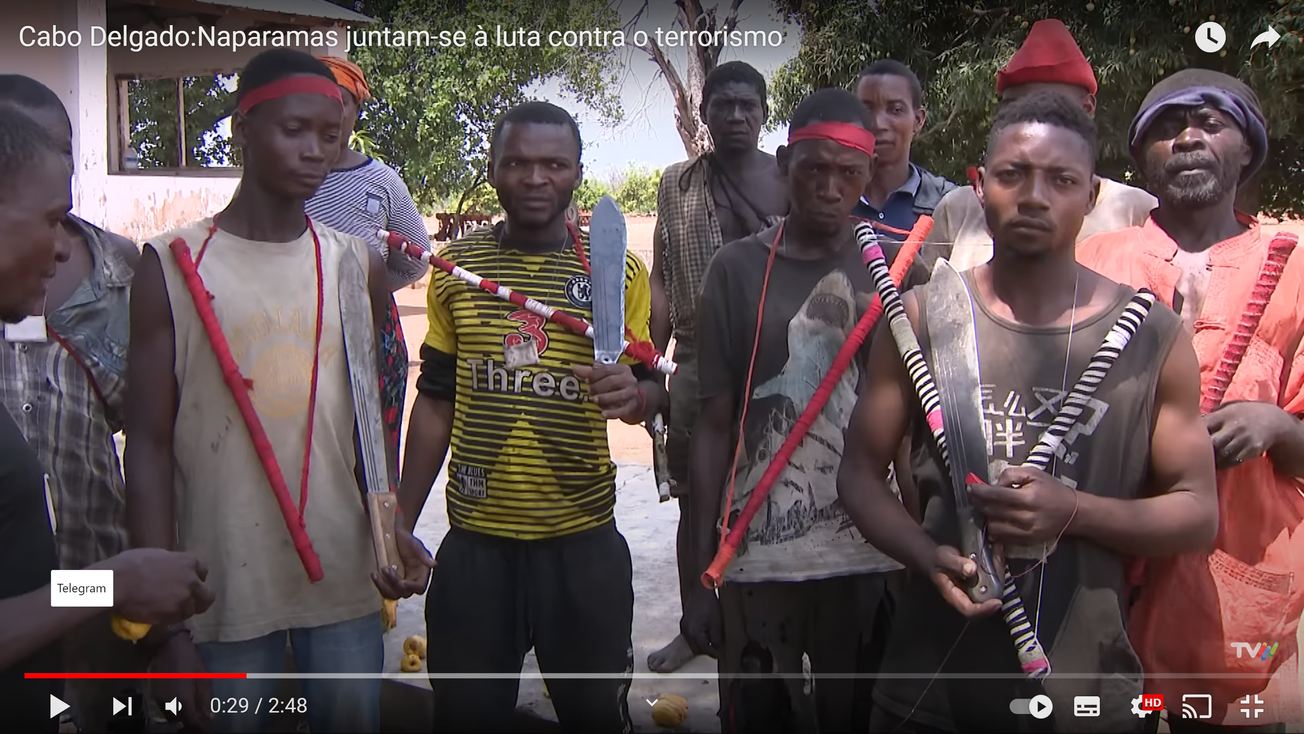From the forthcoming Cabo Ligado Monthly report, to be published on www.caboligado.com
In an unusual video published by Islamic State (IS) on 6 February, masked fighters interview a shirtless man, kneeling in front of an IS flag, with a distinctive red bandana tied around his forehead. The man, he says, is a member of the Naparama – a recently formed militia with mystical beliefs that has inspired men across Cabo Delgado province to enlist in the fight against the insurgency. Its members believe a magic ritual makes them impervious to gunfire; but the man in the video has just been captured, and out of shot more than a dozen of his comrades lie dead, piled on top of each other, punctured with bullet wounds.
“There were 31 of them and by God’s will 14 of them have been sent to hell,” says an IS fighter from behind the camera. “This one will soon meet his fellows.”
The video was filmed in the forest around Iba village in Meluco district, but it was in Cabo Delgado’s southern Namuno district, 200 km away, that the Naparama emerged three months ago, seemingly from nowhere, to become one of the province’s most prominent fighting forces.
Their first appearance was on 10 November 2022. As insurgents tore through Namuno, which had not been hit since the start of the conflict until October 2022, reports circulated on WhatsApp that a new civilian militia, calling themselves the ‘Naparama,’ had captured up to 19 insurgents and killed five.
By the end of November, it was clear that this nascent group had rapidly expanded, with bands of fighters pursuing insurgents across Balama and Montepuez districts. In early December, the first secretary of Frelimo in Cabo Delgado invited them to operate their own checkpoints and roadblocks. Around the same time, rumors spread that villages as far away as in Macomia district were raising funds to send their young men to Namuno to be inducted into the Naparama.
The explosive popularity of this group may be rooted in the infamous reputation of its predecessor of the same name, which formed in the late 1980s to fight on the Frelimo side of the Mozambican civil war. This original iteration of the Naparama was conceived by a traditional healer named Manuel António in Zambezia province, who claimed that a vision from Jesus Christ had led him to invent a medicine that turns bullets into water. Taking this potion from village to village, he mobilized a small army of followers to confront the Renamo rebels and bring an end to the war.
Professor Corinna Jentzsch wrote in Violent Resistance, which examines the history of the Naparama in the civil war, that between 1988 and 1989, António attracted several thousand members, and by 1991 his force controlled two-thirds of Mozambique’s northern provinces.
A remarkable aspect of this achievement was that the Naparama eschewed guns, fighting only with ‘weapons of cold steel’ such as spears, machetes, and bows and arrows, according to Jentzsch. Their preferred mode of attack involved charging the enemy en masse, singing as loudly as they could. This made a terrifying spectacle that often scared young, untrained Renamo fighters into retreat.
The revived Naparama in Cabo Delgado have inherited many of these traditions. Fighters are still ‘vaccinated’ by cutting the chest, traditionally with a razor, and inserting the potion into the wounds. The captured Naparama fighter in the IS video has visible scarring on his body.
Its leadership structure is unclear. António himself died in battle with Renamo in December 1991. The potion is said to only be effective when certain rules are observed, such as refusing to retreat, or eating particular kinds of food. The failure of the potion is usually ascribed to the violation of these rules.
The modern Naparama are also known to go into battle chanting songs and armed with steel weapons, as was reported following their clash with insurgents at Nairoto in Montepuez on 22 November. However, IS claimed to have captured several rifles from the Naparama at Iba, which can be seen in the photos on social media. It cannot be independently confirmed whether they belonged to the Naparama, but the Simonov rifle is often used by Local Forces.
The Naparama’s unique appearance is a large aspect of their identity. When American journalist Michael Hiltzik met with the Naparama in 1990, he reported that a “tatty shred of red ribbon” tied to their clothes was their only uniform. This has also been readopted.
Much is still unknown about the Naparama and how they are organized. Their total number cannot be ascertained, but they have already established themselves as major actors in the conflict, even participating in operations alongside military forces. Perhaps more significantly, the Naparama represent an organized attempt by the local people of Cabo Delgado to fight the insurgency on their own terms. Jentzsch wrote that the Naparama’s message of defiance in the 80s and 90s “reclaimed civilians’ agency over a war that had reduced them to spectators.” This may prove to be their most salient commonality with the Naparama of today.









